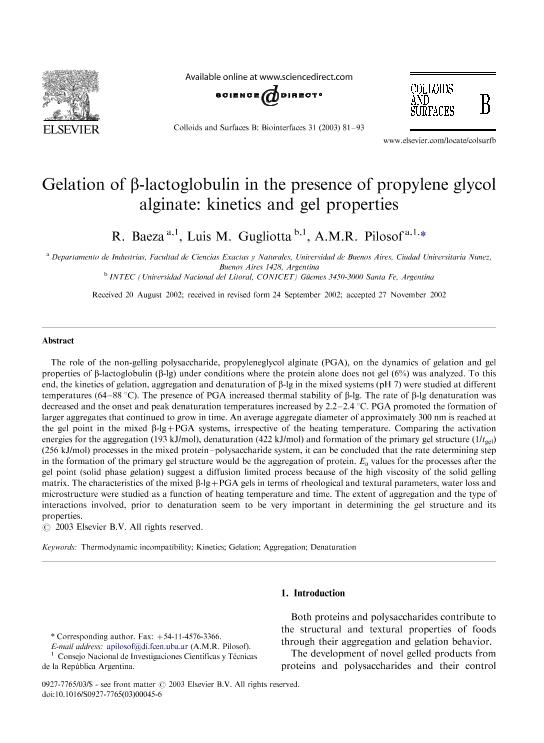Mostrar el registro sencillo del ítem
dc.contributor.author
Baeza, Rosa Isabel

dc.contributor.author
Gugliotta, Luis Marcelino

dc.contributor.author
Pilosof, Ana Maria Renata

dc.date.available
2017-11-21T13:51:16Z
dc.date.issued
2003-12
dc.identifier.citation
Baeza, Rosa Isabel; Gugliotta, Luis Marcelino; Pilosof, Ana Maria Renata; Gelation of beta-lactoglobulin in the presence of propylene glycol alginate: kinetics and gel properties; Elsevier Science; Colloids and Surfaces B: Biointerfaces; 31; 1-4; 12-2003; 81-93
dc.identifier.issn
0927-7765
dc.identifier.uri
http://hdl.handle.net/11336/28588
dc.description.abstract
The role of the non-gelling polysaccharide, propyleneglycol alginate (PGA), on the dynamics of gelation and gel properties of β-lactoglobulin (β-lg) under conditions where the protein alone does not gel (6%) was analyzed. To this end, the kinetics of gelation, aggregation and denaturation of β-lg in the mixed systems (pH 7) were studied at different temperatures (64–88 °C). The presence of PGA increased thermal stability of β-lg. The rate of β-lg denaturation was decreased and the onset and peak denaturation temperatures increased by 2.2–2.4 °C. PGA promoted the formation of larger aggregates that continued to grow in time. An average aggregate diameter of approximately 300 nm is reached at the gel point in the mixed β-lg+PGA systems, irrespective of the heating temperature. Comparing the activation energies for the aggregation (193 kJ/mol), denaturation (422 kJ/mol) and formation of the primary gel structure (1/tgel) (256 kJ/mol) processes in the mixed protein–polysaccharide system, it can be concluded that the rate determining step in the formation of the primary gel structure would be the aggregation of protein. Ea values for the processes after the gel point (solid phase gelation) suggest a diffusion limited process because of the high viscosity of the solid gelling matrix. The characteristics of the mixed β-lg+PGA gels in terms of rheological and textural parameters, water loss and microstructure were studied as a function of heating temperature and time. The extent of aggregation and the type of interactions involved, prior to denaturation seem to be very important in determining the gel structure and its properties.
dc.format
application/pdf
dc.language.iso
eng
dc.publisher
Elsevier Science

dc.rights
info:eu-repo/semantics/openAccess
dc.rights.uri
https://creativecommons.org/licenses/by-nc-sa/2.5/ar/
dc.subject
Thermodynamic Incompatibility
dc.subject
Kinetics
dc.subject
Gelation
dc.subject
Aggregation
dc.subject
Denaturation
dc.subject.classification
Alimentos y Bebidas

dc.subject.classification
Otras Ingenierías y Tecnologías

dc.subject.classification
INGENIERÍAS Y TECNOLOGÍAS

dc.title
Gelation of beta-lactoglobulin in the presence of propylene glycol alginate: kinetics and gel properties
dc.type
info:eu-repo/semantics/article
dc.type
info:ar-repo/semantics/artículo
dc.type
info:eu-repo/semantics/publishedVersion
dc.date.updated
2017-11-16T14:52:50Z
dc.journal.volume
31
dc.journal.number
1-4
dc.journal.pagination
81-93
dc.journal.pais
Reino Unido

dc.journal.ciudad
Oxford
dc.description.fil
Fil: Baeza, Rosa Isabel. Universidad de Buenos Aires; Argentina
dc.description.fil
Fil: Gugliotta, Luis Marcelino. Consejo Nacional de Investigaciones Científicas y Técnicas. Centro Científico Tecnológico Conicet - Santa Fe. Instituto de Desarrollo Tecnológico para la Industria Química. Universidad Nacional del Litoral. Instituto de Desarrollo Tecnológico para la Industria Química; Argentina
dc.description.fil
Fil: Pilosof, Ana Maria Renata. Universidad de Buenos Aires; Argentina
dc.journal.title
Colloids and Surfaces B: Biointerfaces

dc.relation.alternativeid
info:eu-repo/semantics/altIdentifier/doi/http://dx.doi.org/10.1016/S0927-7765(03)00045-6
Archivos asociados
